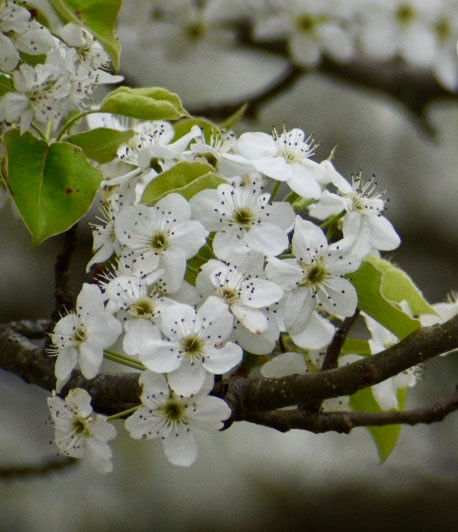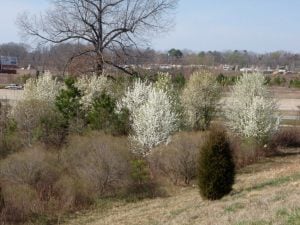Did you know this popular ornamental tree is invasive?
You’ve certainly seen it all around – in neighborhoods, along city streets, along the highways, in the local plant nurseries – even if you don’t know it by name. It blooms early in the spring with an abundance of small white flowers.

Pyrus Calleryana Flower by Cathy Dewitt CC BY 4.0
So what’s the problem?
As with most stories, it began long ago, in a far-away place, and seemed like a good idea at the time.
This plant was first imported from Asia (by seed) in the early 1900’s by the horticulture industry in search of a blight resistant species to graft into the pear orchards (which were having a big problem with fire blight). It proved to be “sort of” helpful, but then it was also found to be a desirable “ornamental” in the early 1950’s. And it was this propagation as an ornamental tree that enabled it’s widespread invasiveness. And now it’s everywhere…. crowding out the native plants.

In fact, it is so invasive that currently Ohio, South Carolina and Pennsylvania prohibit it’s sale and planting.
If you do a quick search on the Bradford (or Callery) Pear you’ll see multiple calls to get rid of it!, don’t plant it!, cut it down!, destroy it! And yes, if you’ve got one or a few, and can do your part in replacing an invasive plant with a beneficial native tree, by all means do. But it may not solve the bigger problem of these trees are everywhere!
Here’s where it gets interesting. There is a possible solution for this bigger problem but it requires time and dedication. So, how can we make these pear trees less invasive?
I recommend reading this wonderfully written and informative (with photos!) blog on this problematic pear tree.
Here’s the link: elizapples.com/2021/03/29/in-defense-of-bradford-pear/
Also recommended is the NC State Extension site
https://plants.ces.ncsu.edu/plants/pyrus-calleryana/
for continuing in-depth info along with more photos.
For those of you who are going to replace a Bradford with a native tree, give us a call. Tree removal is one of the things we do. And once that problematic Bradford Pear is gone we’d recommend planting a Serviceberry, or Flowering Dogwood, or Redbud or some other native tree of your choice in it’s place.
Bradley Tree & Landscape

